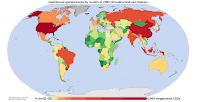 Science Daily: Monitoring Earth's rising greenhouse gas levels will require a global data collection network 10 times larger than the one currently in place in order to quantify regional progress in emission reductions, according to a new research commentary by University of Colorado and NOAA researchers appearing in the April 25 issue of Science.
Science Daily: Monitoring Earth's rising greenhouse gas levels will require a global data collection network 10 times larger than the one currently in place in order to quantify regional progress in emission reductions, according to a new research commentary by University of Colorado and NOAA researchers appearing in the April 25 issue of Science.The authors, CU-Boulder Research Associate Melinda Marquis and National Oceanic and Atmospheric Administration scientist Pieter Tans, said with atmospheric carbon dioxide concentrations now at 385 parts per million and rising, the need for improved regional greenhouse gas measurements is critical. While the current observation network can measure CO2 fluxes on a continental scale, charting regional emissions where significant mitigation efforts are underway -- like
"The question is whether scientists in the
While CO2 levels are climbing by 2 parts per million annually -- a rate expected to increase as



No comments:
Post a Comment